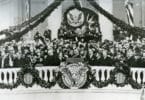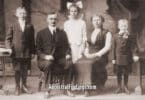Warren G. Harding, the 29th president of the United States, came into office during a time of great transition. Following the tumultuous years of World War I and the progressive reforms of Woodrow Wilson, the country was yearning for stability. Harding’s campaign message of a “Return to Normalcy” resonated deeply with Americans who were eager for less international engagement and more domestic focus. He would go on to serve from 1921 until his untimely death in 1923, a presidency marked by scandal, economic prosperity, and a push to restore a pre-war America.
Early Life and Political Rise
Born on November 2, 1865, in Blooming Grove, Ohio, Harding grew up in a rural setting. He was the eldest of eight children and had a relatively modest upbringing. His father, a farmer-turned-doctor, and his mother, a midwife, instilled in him the values of hard work and resilience. After attending Ohio Central College, Harding embarked on a career in journalism, eventually becoming the publisher of the Marion Star, a small but influential Ohio newspaper.
His charm and connections in Ohio’s Republican Party led him into politics. Harding was a natural politician: friendly, good-looking, and possessing a warm, easygoing demeanor. He worked his way up, becoming an Ohio state senator, then lieutenant governor, and finally a U.S. senator by 1915. In many ways, his rise reflected the classic American dream of moving from humble beginnings to the highest echelons of power.
1920 Presidential Campaign
Harding was something of a compromise candidate during the 1920 Republican convention. Though he wasn’t a frontrunner, his genial nature, ties with party insiders, and reputation as a safe, electable choice made him an ideal candidate in the eyes of many party leaders. Harding ran a campaign focused on healing the nation after World War I. His famous promise of a “Return to Normalcy” signaled a shift away from Wilson’s progressive ideals and international entanglements.
It’s important to note the context in which Harding ran. America had just emerged from one of the most devastating global conflicts in history. The Treaty of Versailles, which Wilson championed, had created intense divisions in the country, and Wilson’s push for the League of Nations was widely unpopular. Harding capitalized on this mood of discontent and won a landslide victory against Democratic opponent James M. Cox.
Domestic Policy and the Economy
One of Harding’s main focuses was economic recovery. The post-war period had seen a brief depression, and Harding sought to stabilize the economy through conservative fiscal policies. His administration worked to reduce taxes, particularly for corporations and the wealthy, believing it would stimulate growth. Harding also reduced government spending and sought to limit the scope of federal intervention in the economy, a stark contrast to the progressive reforms of his predecessor.
The result was an era of economic prosperity, often called the “Roaring Twenties,” though much of that boom took off after Harding’s death. Nonetheless, his administration laid the groundwork for it. The Fordney-McCumber Tariff of 1922, which raised tariffs on imported goods to protect American industries, was another key element of his economic policy. However, while it helped some sectors, it also contributed to growing global trade tensions.
Harding’s administration also oversaw a push for civil rights by advocating for anti-lynching laws. He became the first sitting president to visit the Deep South and speak out against racial violence, but his efforts were largely symbolic as he failed to push meaningful legislation through a Congress controlled by Southern Democrats.
Scandals: The Shadow Over Harding’s Legacy
Unfortunately, Harding’s presidency is often remembered more for the scandals that erupted than for his policies. Harding himself was a popular figure, but he placed too much trust in his friends and political allies, many of whom used their positions for personal gain. The most infamous scandal was the Teapot Dome Scandal, where members of Harding’s administration were found guilty of accepting bribes in exchange for leasing oil reserves in Wyoming to private companies. While Harding was not personally implicated, the scandal cast a dark shadow over his presidency and tarnished his legacy.
Other scandals, including the involvement of his Veterans Bureau head in embezzlement, further stained his administration. Harding reportedly regretted trusting too many of the wrong people, famously saying,
“I have no trouble with my enemies… but my friends, they’re the ones that keep me walking the floors at night.”
Foreign Policy: Isolationism and Arms Reduction
In foreign policy, Harding sought to move the U.S. away from the internationalism of the Wilson years. He rejected the League of Nations and signed the Washington Naval Treaty of 1922 to prevent an arms race among the world’s major naval powers. This treaty is often seen as one of the few successful disarmament efforts of the time, and it temporarily eased tensions in the Pacific region.
Harding also prioritized peace in Latin America and maintained a hands-off approach to European reconstruction, though his administration did provide loans to war-torn European nations through the Dawes Plan (initiated after his death).
Harding’s Personal Life and Untimely Death
Harding’s personal life was full of contradictions. While he was outwardly genial and devoted to his wife, Florence Harding, their marriage was strained, and he had several extramarital affairs. His most famous affair, with Nan Britton, resulted in a daughter, and Britton’s revelations about their relationship after Harding’s death shocked the nation.
In the summer of 1923, Harding embarked on a nationwide speaking tour called the “Voyage of Understanding,” aimed at reconnecting with the public. However, his health began to deteriorate during the trip. He collapsed in San Francisco and died suddenly on August 2, 1923, likely of a heart attack, though rumors of poisoning circulated for years.
Legacy: A Complex Figure
Warren G. Harding is a complex figure in American history. His presidency, while short, came at a crucial moment in the nation’s development. He sought to guide the country back to normalcy and economic prosperity, but his administration became infamous for corruption and scandal. Harding himself was beloved by many during his lifetime, but history has often judged him harshly due to the misconduct of those he trusted.
In recent years, some historians have begun to reevaluate Harding, recognizing his efforts to stabilize the economy, his progressive stance on racial issues, and his work on arms reduction. Still, his legacy remains clouded by the actions of his associates, and he is often ranked as one of the less successful U.S. presidents.
Harding’s presidency reminds us that sometimes, it’s not just policies or speeches that define a leader but the people they choose to surround themselves with. His good-natured trust in his friends ultimately proved his undoing, leaving behind a presidency marked by both achievement and infamy.
Here are some of the best books available on learning more about President Warren G. Harding:
“The Harding Affair: Love and Espionage during the Great War” by James David Robenalt
This book delves into Harding’s personal life, especially his affair with Carrie Phillips, a German sympathizer, and how it intersected with his political career. It provides a fascinating look at the interplay between his private life and national security issues.
“Warren G. Harding” (The American Presidents Series) by John W. Dean
A concise and well-researched biography by John W. Dean, former White House counsel to President Nixon. This book provides a balanced overview of Harding’s life, presidency, and the scandals that defined his administration.
“The Shadow of Blooming Grove: Warren G. Harding in His Times” by Francis Russell
This comprehensive biography explores Harding’s rise to power and his presidency, offering insights into his personal life, political career, and the Teapot Dome scandal. It’s a detailed portrait of Harding and the political environment of his time.
“The Strange Death of President Harding” by Gaston B. Means
A controversial and sensational book that speculates on the circumstances surrounding Harding’s sudden death. Though more of a conspiracy theory than a straightforward biography, it provides an interesting perspective on Harding’s passing mystery.






